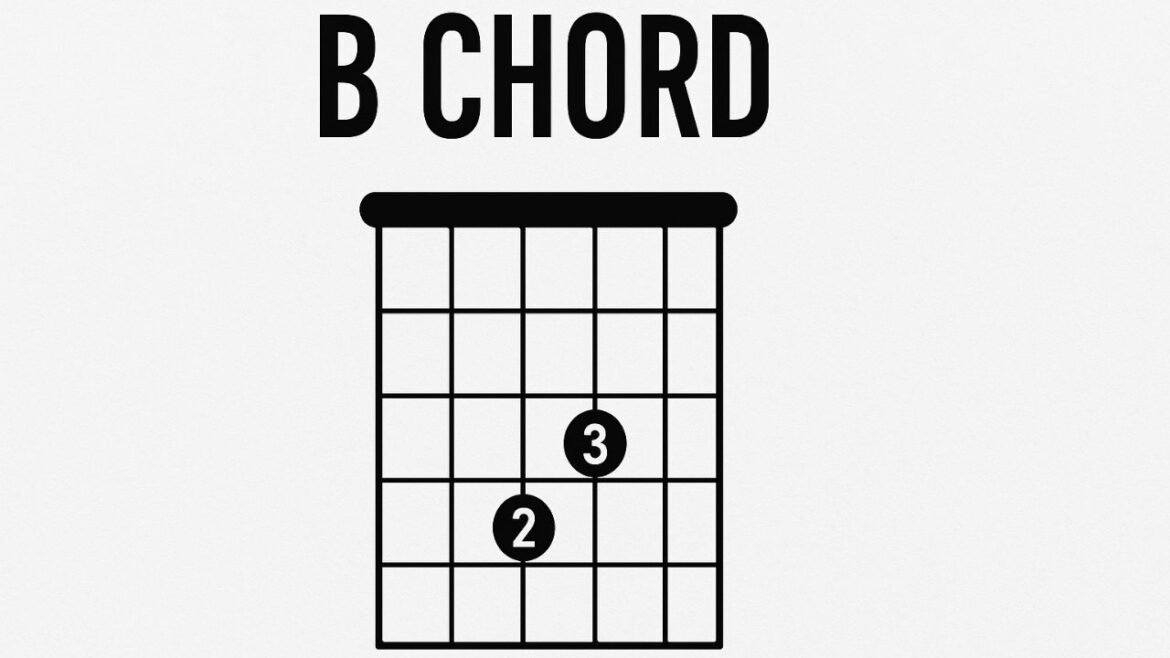If you’re learning guitar, you’ve probably come across the B chord and realized it’s a bit tricky at first. Don’t worry—every guitarist struggles with it in the beginning. The B chord is an important shape that appears in countless songs across pop, rock, country, and blues music. Once you get it right, it opens the door to many new sounds and progressions.
In this guide, we’ll walk through everything you need to know about the B chord—from its basic structure to advanced shapes and creative uses. We’ll keep things simple and easy to understand, even if you’re just starting out.
What Is the B Chord?
In music theory, the B chord refers to the B major chord, one of the twelve major chords in Western music. It’s made up of three notes:
- B – the root note
- D# (D sharp) – the major third
- F# (F sharp) – the perfect fifth
When played together, these notes create a bright, strong sound that’s typical of major chords.
On the guitar, the B chord can be played in several different shapes, depending on your skill level and what kind of sound you’re looking for.
Why the B Chord Is Tricky for Beginners
Unlike open chords such as C or G, the B chord doesn’t have an easy open position. The most common way to play it is as a barre chord, which requires pressing down multiple strings with one finger. This can be uncomfortable at first and might sound muted or buzzy.
But with consistent practice and good finger positioning, you’ll master it faster than you think. Learning the B chord on guitar also improves your finger strength and accuracy—skills that help you with many other chords too.
Basic B Chord Shape (Barre Form)
The most standard version of the B major chord is played on the second fret as a barre chord.
Here’s how to play it:
- Place your index finger across all the strings on the second fret.
- Put your ring finger on the fourth fret of the D (4th) string.
- Middle finger goes on the fourth fret of the G (3rd) string.
- Pinky finger on the fourth fret of the B (2nd) string.
- Strum from the A string (5th) downward. Avoid strumming the low E string.
This shape comes from the A major chord moved up two frets, creating a movable form you can use for any major chord.
Easier Alternatives to the B Chord
If the barre version feels too hard right now, there are simpler shapes you can use while building strength. Here are a few easy B chord alternatives:
1. B Major (Three-Finger Version)
- Index finger on the 2nd fret of the A string
- Ring finger on the 4th fret of the D string
- Pinky finger on the 4th fret of the G string
- Strum only these three strings
This smaller version gives you the main notes of the chord and sounds great in softer songs.
2. B Power Chord (B5)
- Index finger on the 2nd fret of the A string
- Ring finger on the 4th fret of the D string
- Optional pinky on the 4th fret of the G string
This version skips the major third (D#), giving a stronger, heavier sound often used in rock and punk music.
3. B7 Chord (B Dominant 7)
The B7 chord adds a bluesy tone.
- Index finger on the 1st fret of the D string
- Middle finger on the 2nd fret of the A string
- Ring finger on the 2nd fret of the G string
- Pinky finger on the 2nd fret of the high E string
This is easier to play and great for songs in blues or country styles.
Understanding B Chord Variations
The B chord family includes many variations. Let’s look at the most common ones:
B Minor (Bm)
- Notes: B, D, F#
- Mood: Sad, emotional, mellow
- Common shape: Barre across the 2nd fret (based on Am shape)
B Major 7 (Bmaj7)
- Notes: B, D#, F#, A#
- Mood: Dreamy, jazzy, smooth
- Try placing your index on 2nd fret (A string) and build from there.
B Minor 7 (Bm7)
- Notes: B, D, F#, A
- Mood: Relaxed, soulful, modern
- Common in pop and R&B.
B Sus2 & B Sus4
- Bsus2 replaces D# with C# (brighter, open sound)
- Bsus4 replaces D# with E (creates tension that resolves back to B major)
Each of these gives a slightly different emotional color and works in different musical styles.
How to Practice the B Chord
- Start slow: Play one note at a time to make sure each string rings clearly.
- Adjust pressure: You don’t need to press too hard—just enough for clean sound.
- Relax your hand: Avoid tensing up your wrist or thumb.
- Use a metronome: Practice switching between chords (like G → B → E).
- Play songs that use B chords: This makes learning more fun and musical.
Songs like “Wonderwall” by Oasis or “Hotel California” by The Eagles* use variations of the B chord, so practicing with real music helps you remember faster.
Chord Theory – Why the B Chord Matters
In the key of E major, the B chord acts as the V (five) chord, creating tension that resolves beautifully to E major. This is a common movement in countless songs.
In the key of B major, it’s the I chord (home chord)—the tonal center of the song.
Knowing how the B chord functions in different keys helps you understand why it sounds the way it does and how to use it creatively in your progressions.
B Chord Progressions to Try
Here are a few easy B chord progressions for practice:
- B – E – F# – B (classic pop/rock pattern)
- B – G#m – E – F# (common in ballads)
- B – Bmaj7 – E – F#7 (smooth jazz vibe)
- Bm – G – D – A (used in emotional or acoustic songs)
Try strumming slowly and focus on smooth transitions between chords.
Tips to Master the B Chord
- Warm up your fingers with simple stretches before playing.
- Use the tip of your thumb behind the neck for better leverage.
- Roll your index finger slightly when barring to get a cleaner sound.
- Practice muting unwanted strings with your index finger or thumb.
- Be patient—every guitarist has struggled with the B chord at some point
Common Mistakes and How to Fix Them
- Buzzing sounds: You’re not pressing hard enough or your finger angle is off.
- Muted strings: Check that your fingers aren’t accidentally touching nearby strings.
- Fatigue: Take short breaks; build strength gradually.
Over time, your hand will adjust, and the B chord will start to feel natural.
Going Beyond – Advanced Concepts
Once you’re comfortable with basic shapes, explore these advanced B chord ideas:
- Moveable shapes: Slide the B chord shape up and down the neck to form C, D, and others.
- Partial chords: Play only the top three or four strings for lighter textures.
- Add tones: Try Badd9, Bsus2, or B6 for modern pop sounds.
- Chord inversions: Change which note is the lowest for richer harmony.
- Fingerstyle playing: Pick notes individually for a softer, melodic tone.
These advanced forms help you sound more professional and creative in your playing.
FAQS
The B chord is a major chord made of the notes B, D#, and F#. It’s known for its bright and strong sound, often used in pop, rock, and country music.
The B chord is challenging because it usually requires a barre shape, pressing multiple strings with one finger. With practice, finger strength and positioning make it easier to play clearly.
An easier version of the B chord is to play only the top three strings on the second and fourth frets. This gives you the main sound without needing a full barre.
The B chord includes three notes: B (root), D# (major third), and F# (perfect fifth). Together, they create a strong, major sound that works in many progressions.
Many popular songs feature the B chord, such as “Hotel California” by The Eagles and “Wonderwall” by Oasis. It’s a common chord used in different genres for rhythm and melodY
Conclusion
The B chord might seem difficult at first, but once you learn its structure and practice regularly, it becomes a powerful tool in your music journey. Whether you play B major, B minor, or other variations, understanding this chord opens up countless songs and progressions.
Keep your practice fun—learn songs you enjoy, explore new shapes, and listen closely to how the B chord fits into different genres. With patience and consistency, you’ll soon be playing it smoothly and confidently.

